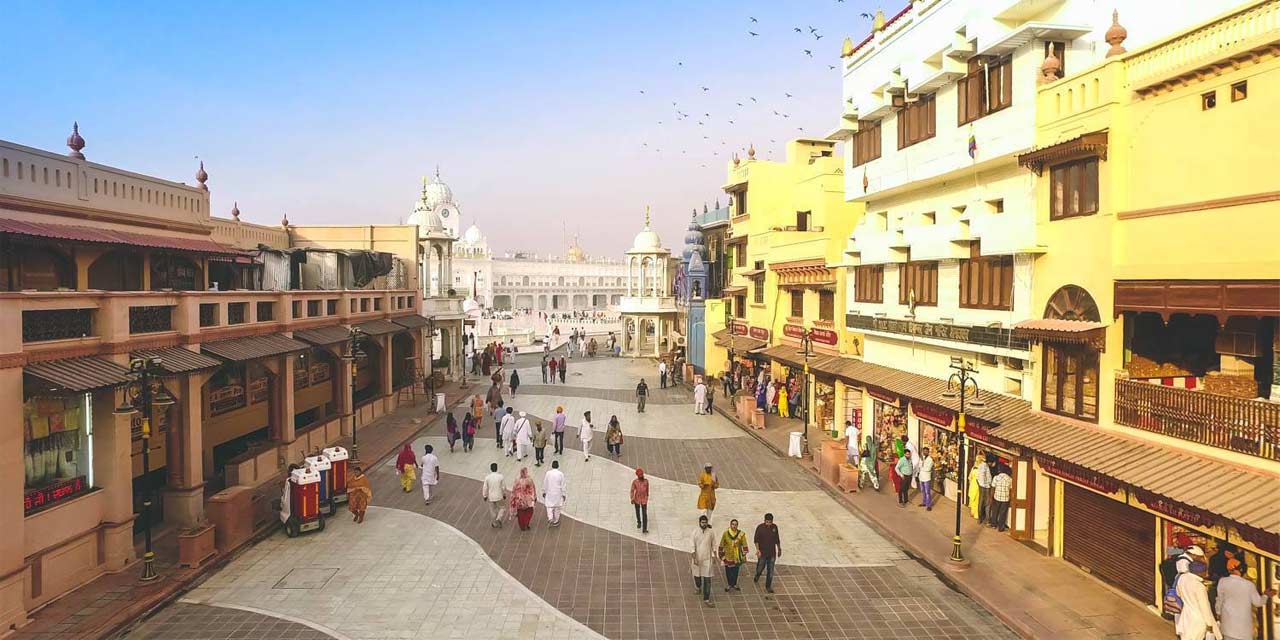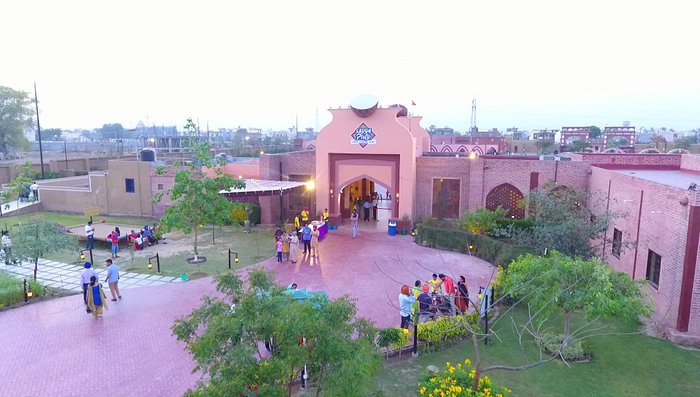- Home
- Holiday Ideas
-
-
- Choose Your Traveling Theme
-
- Adventure Tourism
-
- Cultural Tourism
-
- Tour Packages
-
-
- Packages by State
-
- Holidays by Interest
-
- Popular Tour Packages
-
- Fair And Festivals
-
- Ayurveda And Yoga
-
- Offers
-
- Destinations
-
Amritsar
Sikhism's holy city
Amritsar
A bustling city with an indomitable spirit, Amritsar holds one among the holiest of Sikh ethos at its heart – the Golden Temple. Covered in 400 kg of gold and surrounded by a serene sarovar (pond), one is instantly swamped by the humbling sight of the glistening structure, which is additionally home to at least one of the most important community kitchens (langar) within the country that serves about 20,000 people each day .
Though visitors often make a beeline for the temple, the old-world charm of the town slowly sneaks abreast of them, making them fall crazy with a city that buzzes with spirited and lively nuances. Be it the bullet-ridden walls of Jallianwala Bagh or the energetically charged scene of the Wagah Border, one has got to step into the town to feel the eagerness of thousands of individuals who laid down their lives for the country. the various Indo-British style buildings that dot the city’s landscape stand as a sworn statement to its rich history and significant contribution to the Indian freedom movement.
...
Moreover, the town is understood for its food pilgrimage that’s undertaken in its frenetic and fantastic bazaars that win you over with their diversity and vibrancy. From an array of dishes like butter-drenched paranthas (Indian flatbread), creamy lassi (a drink made from yoghurt), dahi-balla and aloo-tikki (deep-fried savouries), the city’s food is rife with flavours and aromas. However, what makes travelling to the town truly unforgettable is that the warmth of its people.
Amritsar gets its name from the holy tank called Amrit Sarovar, meaning pool of nectar, which surrounds the Golden Temple. Legend has it that the fourth guru of the Sikh faith, Guru Ram Das, founded the town around 1574 AD. it’s said, Guru Amardas, the third Sikh guru, bought a bit of land, amid thick forests, to create a tank. But he died before it might be built. Folklore says Guru Ram Das invited 52 traders from nearby places to settle.
They built 32 shops, which still exist in Amritsar, and are popularly referred to as Batisi Hatta. the development for Amrit Sarovar was completed by his successor Guru Arjan Dev. Interestingly, Amritsar also finds a mention within the Hindu epic, Ramayana, because the place where Lord Rama and Goddess Sita’s twin sons, Luv and Kush, were born. Amritsar was further developed by Maharaja Ranjit Singh, founder and king (1801–39) of the erstwhile kingdom of Punjab.
How to get there ?
By Air
Sri Guru Ram Dassjee International Airport is located 11 km away from Amritsar and is well- connected by domestic and international flights.
By Road
It is easy to drive down to Amritsar from the neighbouring states. The bus services are also on time and comfortable. The bus service to Lahore, the only overland connection between India and Pakistan, starts from Amritsar.
Rail
All major cities of India are well-connected with Amritsar via direct trains. Amritsar Junction is one of the major railheads of the city.
Attractions

Golden Temple
Amritsar is world-famous for the gorgeous and highly revered Golden Temple or Sri Harmandir Sahib, which is one among the foremost prominent spiritual sites within the country. The temple may be a two-storeyed structure with its top half covered in almost 400 kg of pure gold foil , which is what earned it its English moniker. Maharaja Ranjit Singh, the leader of the Sikh empire, is believed to possess initiated the development within the 19th century. the remainder of the temple complex is made in white marble, inlaid with precious and semi-precious colourful stones. to make motifs, the pietra dura technique has been used. The grand temple complex is awe-inspiring in its size.
One must cover one’s head and take away his/her footwear before entering the Golden Temple, as a mark of respect. together listens to the gorgeous notes of gurbani (spiritual songs), the serene spirituality of the temple soothes the soul. One also can partake of the free meal that’s offered here to around 20,000 people a day at the Guru Ka Langar (community meal), no matter caste, creed or gender. the whole process is managed by volunteers and is one among the foremost humbling experiences you’ll have.
The architecture of the temple is spectacular and a 67 ft square of marble makes up the bottom of the structure. The glistening temple is surrounded by Amrit Sarovar (pool of nectar), whose waters are said to possess healing powers. One also can watch colourful fish swim within the lake’s clear blue waters as devotees take a dip in it. The temple has been designed keeping in mind the essential tenets of Sikhism that advocate universal brotherhood and all-inclusive ethos. Thus, it’s accessible from all directions.
The main entrance boasts an imposing tower , which also features a Central Sikh Museum. From here, one can sight spectacular views of the shrine and its elegant silhouette within the Amrit Sarovar. A second entry is thru the silver doors of the gorgeously embellished Darshani Deori, which leads onto the causeway that links the sanctum sanctorum with the Parikrama, the marbled surface surrounding the sarovar.
In the north-west corner of the complex is that the Jubi tree, which is believed to possess special powers. it’s said to possess been planted 450 years ago by the Golden Temple’s first high priest, Baba Buddha.
During the day, the holy book of the Sikhs – the Adi Granth – is kept inside the temple. At night, it’s taken to the Akal Takth or Eternal Throne, that houses ancient weaponry earlier employed by Sikh warriors. There are other famous temples surrounding Sri Harmandir Sahib, including the Durgiana Temple also as a gorgeous garden and therefore the tower of Baba Atal. it’s said that sage Valmiki wrote the epic Ramayana during this sacred place.
Amritsar Heritage Walk
The term refers to a guided tour which covers the town of Amritsar knee deep exploring the bulk of parts of the town and a comprehensive check out the city’s 4 century old history. The walk covers a distance of about 3 kilometers; you’ll get to go to all the Akhara Bungas, Hattis, Havelis and Katras that characterize the majestic town.


Jallianwala Bagh
Jallianwala Bagh in Amritsar is that the site of 1 of the most important tragedies in Indian history. On April 13, 1919, this park, spread across 7 acre, saw about 2,000 Indians indiscriminately shot dead at the hands of British soldiers lead by General O’Dyer. This incident is understood because the Jallianwala Bagh massacre or the Amritsar massacre. Historical records tell that on the fateful day of the Punjabi harvest festival of Baisakhi, 15,000 to 20,000 people had gathered to celebrate. aside from this, some people had also close to carry a peaceful demonstration against the repressive Rowlatt Act that provided for stricter control of the press, arrests without warrant and indefinite detention without trial. British acknowledged of it and surrounded the park armed with rifles. Then, on General O’Dyer’s orders, shots were fired indiscriminately over men, women and youngsters .
The wall near the top of the park still holds the marks of around 36 bullets. After the shooting, several dead bodies had to be taken out of the well which individuals jumped into to avoid being shot. A memorial is made here to commemorate the two ,000 Indians who were killed or wounded. The story of this appalling massacre is told within the Martyr’s Gallery at the location . The incident was instrumental in changing the course of the Indian freedom struggle. It fuelled anger among people, resulting in the Non-cooperation Movement of 1920-22. After the incident, Gandhi declared, “The impossible men of India shall rise and liberate their motherland.”
“This disproportionate severity of punishment inflicted upon the unfortunate people and method of carrying it out is without parallel within the history of civilised govt.” wrote Rabindranath Tagore, a noble laureate, while returning his knighthood to British . it’s a must-visit site while getting to Amritsar.
Wagah Border
The Wagah Border is a military outpost on the Indian and Pakistani border, lying between the cities of Amritsar and Lahore (Pakistan). it’s around 28 km from Amritsar and is one among the most access points overland to the neighbouring country of Pakistan. Among its many buildings, roads and barriers, one can witness the impressive Beating the Retreat ceremony, held here a day . During the ceremony, an infantryman stands at attention on each side of the gate.
Then, the gates are flung open and therefore the two soldiers, one from both India and Pakistan, approach one another , mimic anger and exchange fierce looks. After this, they greet and start to lower both the Indian and therefore the Pakistani flags on either side of the gate simultaneously. People from both countries gather to witness the impressive proceedings. On the Indian side of the border stands an enormous gate with an encryption reading ‘Swarn Jayanti Dwar’ (Golden Jubilee Gate) and one can enjoy a bird’s eye view of the Wagah Border from here. The Lowering the Flag Ceremony may be a must-see in Amritsar because the high-decibel spectacle leaves one in awe.
As night approaches, lights are switched on to mark the top of the day. there’s patriotic fervour within the air as people start singing the anthem and applauding the ceremony. The energy makes for a rare display of pride in one’s country and nationality. Another attraction nearby the Wagah Border may be a complex housing the samadhi of Sham Singh Attari, who was a celebrated general within the army of the Sikh empire. Samadhis of his relations also are there along side a cistern . Nearby is that the Atari railroad station .


Sadda Pind
A unique open-air museum that showcases the culture, heritage and traditions of Punjab, Sadda Pind houses a rare collection of artefacts and buildings. Sprawled over 12 acres, the world has been developed as a country landscape to portray the village lifetime of Punjab.
From brick and stone houses of goldsmiths, ironsmiths, farmers, potters etc., to those of zamindars (land owner) and therefore the sarpanch (village headman), several constructions aptly show the life-style of Punjabi villages. Local artistes perform to traditional melodies all day within the baraat ghar and therefore the village haveli. From bhangra, gidda, kikli and jhumar, there is a lot on display. A must-watch is that the performance of gatka, a sort of Sikh martial arts. Visitors also can enjoys cooking authentic recipes like makki-di-roti (a bread made up of maize) and sarson-ka-saag (a dish prepared with mustard greens). Churning butter and popping popcorn on an open hearth are a number of the opposite unmissable experiences.
Sadda Pind is dotted with kiosks found out by local potters, blacksmiths, weavers and other artisans who display their wares. a number of the simplest buys include phulkari dupattas, jutis, parandis, musical instruments, clay toys, shawls and agricultural implements.
For an intimate rendezvous with Punjabi culture, where you’ll connect together with your roots and enjoy the rich heritage, a visit to Sadda Pind is very recommended.
The Akal Takt
The Akal Takht is one among the 5 Takhts of the Sikh religion and is found within the Golden temple complex. It symbolizes the dispensing of Justice and temporal activity of the Sikh religion and is that the highest seat of the ‘Khalsa’ (a military and authority in Sikh culture) division, and was built by the 6th Guru, Guru Hargobind Ji. The place was established as a logo of opposition to the tyranny of the 17th and 18th century rulers. The Akal Takht also houses the traditional weapons employed by the Sikh warriors.


Ram Bagh Palace
Must pay a visit to ‘MUGHAL PATTERN OF SHALIMAR GARDENS OF LAHORE’, built by Maharaja Ranjit Singh, Sher-e-Punjab, named it in honour of Guru Ram Das Ji. The red stone work was executed by workmen brought from Delhi. The Maharaja used it as residence during his visit to Amritsar. this is often a protected monument under Punjab ancient and Historical vacant lot Act, 1964. The protection of the monument is haunted under Western Circuit as Natural Site.
Gobindgarh Fort
Spread across 43 acre, this beautiful fort dates back 300 years. Long ago, the world-famous Kohinoor diamond wont to be kept inside this fort. The fort was originally built as a mud fortress called Bhagian da Qila by an area chieftain, Gujar Singh Bhangi. The chieftain belonged to a clan called Misls, who ruled the world at that point . The fort was under him for nearly 49 years after which Amritsar was ruled by Gurdit S Bhangi, a descendant of Gujjar Singh. Legend has it that a trader, Arur Mal, was asked by the royalty to pay tribute to the Bhangi township. Refusing to try to to so, he visited a rival town and conspired with Shaikh Kamaluddin and Maharaja Ranjit Singh to invade the fort. Ranjit Singh attacked the town through the Ahluwalia gate and took over the fort.
Since the fort holds great historical prominence, the govt of Punjab has declared it as a historical monument.
Moreover, there are several other constructions within the fort, including Toshakhana and Khas Mahal, along side bastions, moats, wells and havelis built during the reign of Maharaja Ranjit Singh, the leader of the Sikh empire. There are several remnants of British rule also , including the Durbar Hall and therefore the Anglo Sikh Bungalow. One also will find a bell, which was made in Sheffield, the UK.


Gurdaspur
Located around 75 km from Amritsar, Gurdaspur was founded by Guriyaji Mahant within the 17th century. Flanked by Rivers Beas and Ravi, this major city of Punjab is that the northern-most district of the state. the town has immense historical and spiritual significance and it’s said that Mughal emperor Akbar was enthroned here.
Alexander, the Great, is additionally said to possess fought one among his many battles within the city. the most attraction is Batala, situated 30 km away, which is claimed to be the place where Nanak got married. The gurdwara, where the ceremony was held, called the Kandh Sahib, draws visitors from far and wide. Batala is additionally the location of the tomb of Sher Khan, foster brother of Akbar. The tomb may be a beautiful example of Mughal architecture and invites visitors from round the area. Nearby Batala, lies Qadian, which is that the birthplace of Mirza Ghulam Ahmad, the founding father of the Ahmediyah community.
Other attractions in Gurdaspur include the palace built by Maharaja Sher Singh, son of Maharaja Ranjit Singh and therefore the tomb of Sayid Imam Ali Shah, a sufi saint. Gurdaspur also boasts a serious natural wetland called Keshopur, which attracts thousands of migratory birds from Central Asia and Siberia in winters. the favored species one can sight are wigeon, dub chick, black ibis, gadwall, common teal, pintail and Northern shovelercan.
Pragpur
About 167 km from Amritsar, lies the scenic town of Pragpur, nestled within the state of Himachal Pradesh. Declared as a Heritage Village in 1997, it’s perched at an elevation of about 1,800 ft above water level . the whole village has been established around a famous pond, called Afrikaans . While the pond may be a quaint natural retreat, visitors also wish to pray at the nearby Radha Krishna Mandir, dedicated to Lord Krishna and Goddess Radha. There are many heritage buildings dotting the landscape, a number of which include Bhutail Niwas, a 100-year-old building, and therefore the Judge’s Court, which may be a manor inbuilt the Indo-European sort of architecture.
The town is additionally popular for the varied festivals that are celebrated with great fervour. Lohri is one such occasion that celebrates the movement of the sun from the hemisphere to the hemisphere . The Wrestling Festival, organised during the month of September, also draws huge crowds.


Kapurthala
This city in Punjab is understood for the marvellous architecture of its monuments and gardens, which are inbuilt Indo-Saracenic and French styles. the town was founded within the 11th century by Rana Kapur (after whom the town has been named) of Jaisalmer.
The main attraction in Kapurthala is that the Jagatjit Palace, which was the residence of the erstwhile maharaja. inbuilt 1908, many believe that it’s modelled after the famous Versailles Palace in France. Presently, it’s under the care of Sainik School to coach and prepare boys for the National Defence Academy (NDA). The Elysee Palace is additionally worth a visit as its monolithic structure and delightful facade are a treat for the eyes. it had been inbuilt 1962 by Kanwar Bikram Singh within the Indo-French sort of architecture. Moorish Mosque and Panch Mandir are a number of the opposite places that warrant a visit. Photography enthusiasts can make a beeline for the Kanjli Wetland that houses variety of mammals and avifauna. The Kanjli Lake makes for an excellent picnic spot with its picturesque views and amazing surroundings. For science enthusiasts, the Pushpa Gujral Science City may be a must-visit. A spiritual site to go to near the town is Sultanpur Lodi, which is understood for its association with Nanak , the founding father of Sikhism.
Kapurthala is closely related to the founding father of the Ahluwalia dynasty, Baba Jassa Singh, who ruled it for several years. Jagatjit Singh, who was enthroned here in 1877 and ruled the town for 71 years is believed to possess been the architect of the fashionable city. Under his reign, Kapurthala acquired a central , a contemporary sewage and water system, an improved judiciary, free and compulsory primary education, a state assembly and state council etc.
Jalandhar
Located around 80 km from Amritsar, Jalandhar may be a busy city located within the plains between the Beas and Sutlej rivers. The name Jalandhar means a neighborhood that lies under water and lots of believe that the name has been derived from its location between two rivers. it’s one among the most important cities within the state and thus has no shortage of tourist opportunities. While visiting this city, one can attend the sacred town of Kartapur, which hosts an annual fair to celebrate Guru Arjan Dev’s birth. Nearby stands Nur Mahal, best known for the ruins of a gorgeous medieval sarai (inn) built by Mughal queen Nur Jahan; and Phillaur, known for its fort and archaeological sites dating back to the Harappan period.
Other attractions of the place include St Mary’s Cathedral Church, the Gurdwara Chhevin Padshahi, and therefore the Devi Talab, dedicated to Vrinda, wife of the demon king Jalandhar. Another town on the brink of Jalandhar that’s worth a visit is Nakodar. It houses two architectural marvels: the tombs of court musicians Mohammad Momin and Haji Jamal. The Pir of Baba Murad Shah, a sufi (Muslim mystic order) saint also lies here. A grand festival is held in September that draws musicians and singers from everywhere the state. one among the oldest serious music festivals within the world, the Harballabh Sangeet Festival, is held in December.
Jalandhar served because the capital of Punjab until 1953 before Chandigarh acquired that status. Steeped in heritage and legends, it’s mentioned within the Puranas (sacred Hindu literature) and therefore the Hindu epic Mahabharata also .
A legend says the region was once ruled by Danava Jalandhara, an offspring of River Ganga. Historically, the world round the city dates back to the Indus Valley civilisation, with numerous sites yielding traces of ancient settlements. Jalandhar was also home to several Buddhist viharas. Today, it’s one among India’s most prominent sports goods manufacturing hubs. About 318 major items are manufactured here, including cricket bats and balls, sports equipment , hockey sticks and balls, inflatable balls, fishing equipment, carom and chess boards and other protective equipment.

WANT TO RENT A CAR IN INDIA ?
Choose Your Traveling Theme

 TOUR BOOKING
TOUR BOOKING















